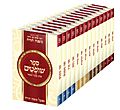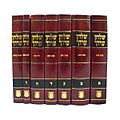Halakha facts for kids
| Part of a series on | |||
|---|---|---|---|
|
|||
| Judaism | |||
| Category | |||
| Jewish religious movements | |||
| Orthodox (Haredi • Hasidic • Modern) | |||
| Conservative • Reform | |||
| Reconstructionist • Renewal • Humanistic | |||
| Jewish philosophy | |||
| Principles of faith • Kabbalah • Messiah • Ethics | |||
| Chosenness • Names of God • Musar | |||
| Religious texts | |||
| Tanakh (Torah • Nevi'im • Ketuvim) | |||
| Ḥumash • Siddur • Piyutim • Zohar | |||
| Rabbinic literature (Talmud • Midrash • Tosefta) | |||
| Religious Law | |||
| Mishneh Torah • Tur | |||
| Shulchan Aruch • Mishnah Berurah | |||
| Kashrut • Tzniut • Tzedakah • Niddah • Noahide laws | |||
| Holy cities | |||
| Jerusalem • Safed • Hebron • Tiberias | |||
| Important figures | |||
| Abraham • Isaac • Jacob | |||
| Moses • Aaron • David • Solomon | |||
| Sarah • Rebecca • Rachel • Leah | |||
| Rabbinic sages | |||
| Jewish life cycle | |||
| Brit • Pidyon haben • Bar/Bat Mitzvah | |||
| Marriage • Bereavement | |||
| Religious roles | |||
| Rabbi • Rebbe • Posek • Hazzan/Cantor | |||
| Dayan • Rosh yeshiva • Mohel • Kohen/Priest | |||
| Religious buildings & institutions | |||
| Synagogue • Beth midrash • Mikveh | |||
| Sukkah • Chevra kadisha | |||
| Holy Temple / Tabernacle | |||
| Jewish education | |||
| Yeshiva • Kollel • Cheder | |||
| Religious articles | |||
| Sefer Torah • Tallit • Tefillin • Tzitzit • Kippah | |||
| Mezuzah • Hanukiah/Menorah • Shofar | |||
| 4 Species • Kittel • Gartel | |||
| Jewish prayers and services | |||
| Shema • Amidah • Aleinu • Kaddish • Minyan | |||
| Birkat Hamazon • Shehecheyanu • Hallel | |||
| Havdalah • Tachanun • Kol Nidre • Selichot | |||
| Judaism & other religions | |||
| Christianity • Islam • Judeo-Christian | |||
| Abrahamic faiths | |||
| Related topics | |||
| Antisemitism • The Holocaust • Israel • Zionism | |||
Halakha is a Hebrew word for the Jewish laws that guide how Jewish people live their lives. It's like a set of rules and traditions that help Jewish people understand how to follow God's commands.
The History of Halakha
For a long time, these laws were passed down by word of mouth. They weren't written down in books. People learned them by listening and remembering.
Later, in the 1st and 2nd centuries CE (which means Common Era, or after the year 0), wise Jewish teachers called rabbis decided to write these laws down. This written collection of laws is known as the Mishnah. It helped make sure everyone understood the laws in the same way.
What Halakha Covers
Halakha covers many different parts of daily life for Jewish people. It includes rules about:
- How to celebrate holidays and festivals.
- What foods are allowed to be eaten (called kosher laws).
- How to pray and worship.
- How to act towards other people.
- Rules for marriage and family life.
It's a way for Jewish people to connect with their faith and traditions every day.
Images for kids
-
A full set of the Babylonian Talmud, which includes the Mishnah and other discussions.
-
A mixed-gender service at the Western Wall, showing different ways Jewish people practice their faith.
See also
 In Spanish: Halajá para niños
In Spanish: Halajá para niños











